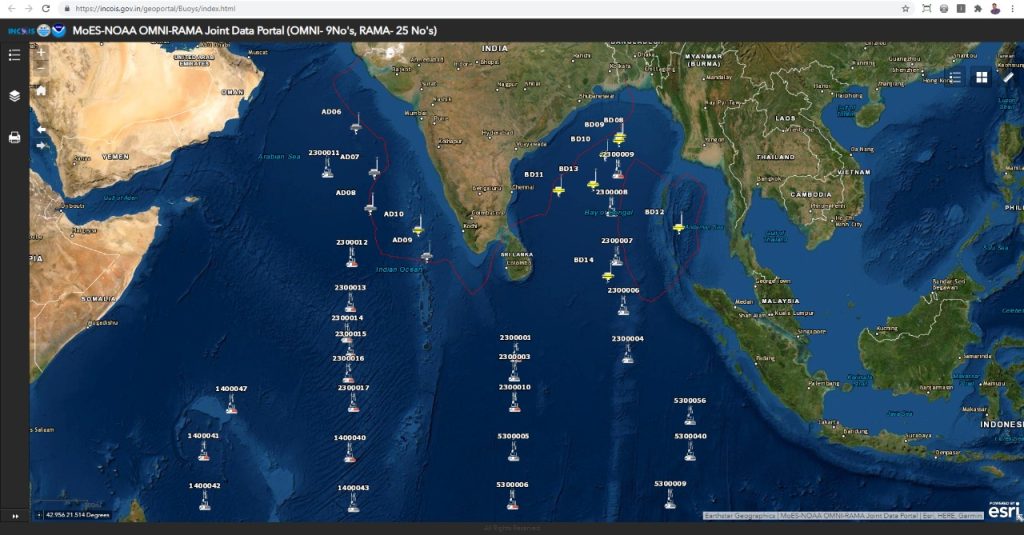 On August 9, 2021, representatives from NOAA and the Ministry of Earth Sciences (MoES) of India signed an updated partnership agreement that marks more than 12 years of partnership between these nations in the name of ocean and atmospheric observations for improved weather and climate prediction. The virtual signing ceremony included a live demonstration of a new joint oceanographic data portal that makes data from the RAMA-OMNI moored buoy array in the Indian Ocean publicly available for the benefit of global science, forecasting, and disaster preparedness.
On August 9, 2021, representatives from NOAA and the Ministry of Earth Sciences (MoES) of India signed an updated partnership agreement that marks more than 12 years of partnership between these nations in the name of ocean and atmospheric observations for improved weather and climate prediction. The virtual signing ceremony included a live demonstration of a new joint oceanographic data portal that makes data from the RAMA-OMNI moored buoy array in the Indian Ocean publicly available for the benefit of global science, forecasting, and disaster preparedness.
This partnership with India supports the Biden Administration’s priorities for a “free, open, inclusive [and] healthy” Indo-Pacific region, as described in the joint statement from the summit between Japan, India, Australia, and the United States in early March.
“The Indian Ocean is where the monsoon patterns arise that will impact the agriculture and the economic activity of India. But it’s the same basin as well where weather begins that affects North America,” said Craig McLean, NOAA Assistant Administrator for Oceanic and Atmospheric Research. “Our weather in the Americas, the farmlands and what we declare as the production belt of wheat and other crops in the United States – our Midwest – it’s told in advance by understanding what is happening in the Indian Ocean.”
McLean and G. A. Ramadass, Director of the National Institute of Ocean Technology, MoES, signed the partnership agreement on behalf of their respective organizations. Ambassador Sundhakar Dalela, Deputy Chief of Mission with the Embassy of India in Washington, D.C., and Ashutosh Sharma, MoES Acting Secretary, provided opening remarks. Sidney Thurston, RAMA Program Manager of NOAA’s Global Ocean Monitoring and Observing Program, moderated the event. Scientists from NOAA’s Pacific Marine Environmental Laboratory joined their colleagues from the Indian National Center for Ocean Information Services and National Institute for Ocean Technology in the launch of the new data portal.
Initiated in 2004, the Research Moored Array for African-Asian-Australian Monsoon Analysis and Prediction (RAMA) was designed to study the Indian Ocean’s role in monsoons, improve monsoon forecasts, and to better study the historically data-sparse Indian Ocean. The first RAMA buoys were deployed by NOAA in 2004, with the most recent moorings deployed in the Arabian Sea in 2019. MoES has extended operational support to the RAMA array since the earliest deployments. RAMA buoys collect data on a range of atmospheric and oceanic variables, including ocean temperature, salinity, currents, wind, sea level air pressure and humidity. Data collected within RAMA has been extensively used globally and in collaborations between NOAA and MoES scientists to understand the thermohaline structure in the Bay of Bengal, and to validate satellite products and ocean-climate-weather models.
The Ocean Moored Buoys in the Northern Indian Ocean (OMNI) array was initially deployed in 2012, and MoES Research Moored Array for African-Asian-Australian Monsoon Analysis and Prediction in 2018 that data from the open ocean elements of the OMNI array would be open access and shared freely among researchers to help improve the accuracy of forecasts.
The renewed partnership and joint data portal will significantly benefit the U.S., Indian, and global community working in ocean and climate science, forecasting, and disaster preparedness, especially as we enter the UN Decade of Ocean Science for Sustainable Development and look for new ways to address the climate crisis.
As Ambassador Dalela stated at the signing ceremony, “As democracies with shared values, it is important to have open exchange of knowledge, information, and ideas.”
